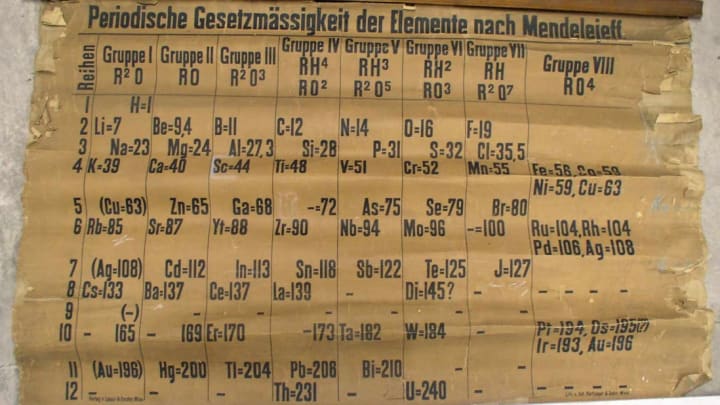Periodic Table Discovered at Scotland's St Andrews University Could Be World's Oldest
By Emily Petsko

The oldest surviving periodic table of elements in the world may have been found at the University of St Andrews in Scotland, according to the Scottish newspaper The Courier.
University researchers and international experts recently determined that the chart, which was rediscovered in a chemistry department storage area in 2014, dates back to 1885—just 16 years after Russian chemist Dmitri Mendeleev invented the method of sorting the elements into related groups and arranging them by increasing atomic weight.
Mendeleev’s original periodic table had 60 elements, while the modern version we use today contains 118 elements. The chart found at St Andrews is similar to Mendeleev’s second version of the table, created in 1871. It’s thought to be the only surviving table of its kind in Europe.
The St Andrews table is written in German, and was presumably produced for German universities to use as a teaching aid, according to St Andrews chemistry professor David O’Hagan. The item itself was dated 1885, but St Andrews researcher M. Pilar Gil found a receipt showing that the university purchased the table from a German catalog in 1888. A St Andrews chemistry professor at the time likely ordered it because he wanted to have the latest teaching materials in the scientific field, even if they weren't written in English.
When university staffers first found the table in 2014, it was in “bad condition,” O’Hagan tells The Courier in the video below. The material was fragile and bits of it flaked off when it was handled. Conservators in the university's special collections department have since worked to preserve the document for posterity.
The 19th century table looks quite a bit different from its modern counterparts. Although Mendeleev laid the groundwork for the periodic table we know today, English physicist Henry Moseley improved it in 1913 by rearranging the elements by the number of protons they had rather than their atomic weight. Then, in the 1920s, Horace Deming created the boxy layout we now associate with periodic tables.
Learn more about the St Andrews discovery in the video below.
[h/t The Courier]